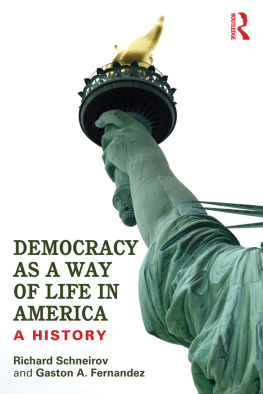Jim Cullen - The Art of Democracy: A Concise History of Popular Culture in the United States
Here you can read online Jim Cullen - The Art of Democracy: A Concise History of Popular Culture in the United States full text of the book (entire story) in english for free. Download pdf and epub, get meaning, cover and reviews about this ebook. year: 2002, publisher: NYU Press, genre: Politics. Description of the work, (preface) as well as reviews are available. Best literature library LitArk.com created for fans of good reading and offers a wide selection of genres:
Romance novel
Science fiction
Adventure
Detective
Science
History
Home and family
Prose
Art
Politics
Computer
Non-fiction
Religion
Business
Children
Humor
Choose a favorite category and find really read worthwhile books. Enjoy immersion in the world of imagination, feel the emotions of the characters or learn something new for yourself, make an fascinating discovery.
- Book:The Art of Democracy: A Concise History of Popular Culture in the United States
- Author:
- Publisher:NYU Press
- Genre:
- Year:2002
- Rating:5 / 5
- Favourites:Add to favourites
- Your mark:
- 100
- 1
- 2
- 3
- 4
- 5
The Art of Democracy: A Concise History of Popular Culture in the United States: summary, description and annotation
We offer to read an annotation, description, summary or preface (depends on what the author of the book "The Art of Democracy: A Concise History of Popular Culture in the United States" wrote himself). If you haven't found the necessary information about the book — write in the comments, we will try to find it.
Jim Cullen: author's other books
Who wrote The Art of Democracy: A Concise History of Popular Culture in the United States? Find out the surname, the name of the author of the book and a list of all author's works by series.
The Art of Democracy: A Concise History of Popular Culture in the United States — read online for free the complete book (whole text) full work
Below is the text of the book, divided by pages. System saving the place of the last page read, allows you to conveniently read the book "The Art of Democracy: A Concise History of Popular Culture in the United States" online for free, without having to search again every time where you left off. Put a bookmark, and you can go to the page where you finished reading at any time.
Font size:
Interval:
Bookmark:
in the United States

photographs and artwork: p. 1, William Claxton; p. 9, American Antiquarian
Society; p. 26, Houghton Library, Harvard University; p. 33, Harvard Theatre
Collection; p. 50, Harry T. Peters Collection, Museum of the City of New York,
originally published by N. Currier, 1849; p. 73, photograph by Gurney & Son,
New York, Sophia Smith Collection, Smith College; p. 87, Harvard Theatre
Collection; p. 121, Harvard Theatre Collection; p. 128, photograph by Adolph
Witterman, Leonard Hassam Bogart Collection, Museum of the City of New
York; p. 135, Bettmann/Corbis; p. 149, Film Stills, Museum of Modern Art; p.
188, photograph by Bradley Smith/Corbis; p. 201, Photofest; p. 217, Photofest;
p. 272, photograph by Fredrik Nilsen, Slash/Warner Brothers Records; p. 278,
photograph by Jan Butchofsky-Houser/Corbis; p. 289, E! Online, Inc. 2002.
All rights reserved
Cullen, Jim, 1962
The art of democracy : a concise history of U.S. popular culture / by
Jim Cullen.2nd ed.
p. cm.
Includes bibliographical references and index.
ISBN 1-58367-065-3 ISBN 1-58367-064-5 (pbk.)
1. Popular cultureUnited StatesHistory. 2. United StatesCivilization. I. Title.
E161 .C85 2002
973-dc21
122 West 27th Street
New York, NY 10001
10 9 8 7 6 5 4
Mari Jo and Paul Buhle,
mentors
The Rise of Popular Culture
The Emergence of Popular Culture, 1800-1860
The Segmentation and Consolidation of Popular Culture, 1860-1900
Popular Culture and Modern Technology, 1900-1945
Popular Culture in the Age of Television and Beyond, 1945-2000
Across the Digital Frontier
Font size:
Interval:
Bookmark:
Similar books «The Art of Democracy: A Concise History of Popular Culture in the United States»
Look at similar books to The Art of Democracy: A Concise History of Popular Culture in the United States. We have selected literature similar in name and meaning in the hope of providing readers with more options to find new, interesting, not yet read works.
Discussion, reviews of the book The Art of Democracy: A Concise History of Popular Culture in the United States and just readers' own opinions. Leave your comments, write what you think about the work, its meaning or the main characters. Specify what exactly you liked and what you didn't like, and why you think so.








